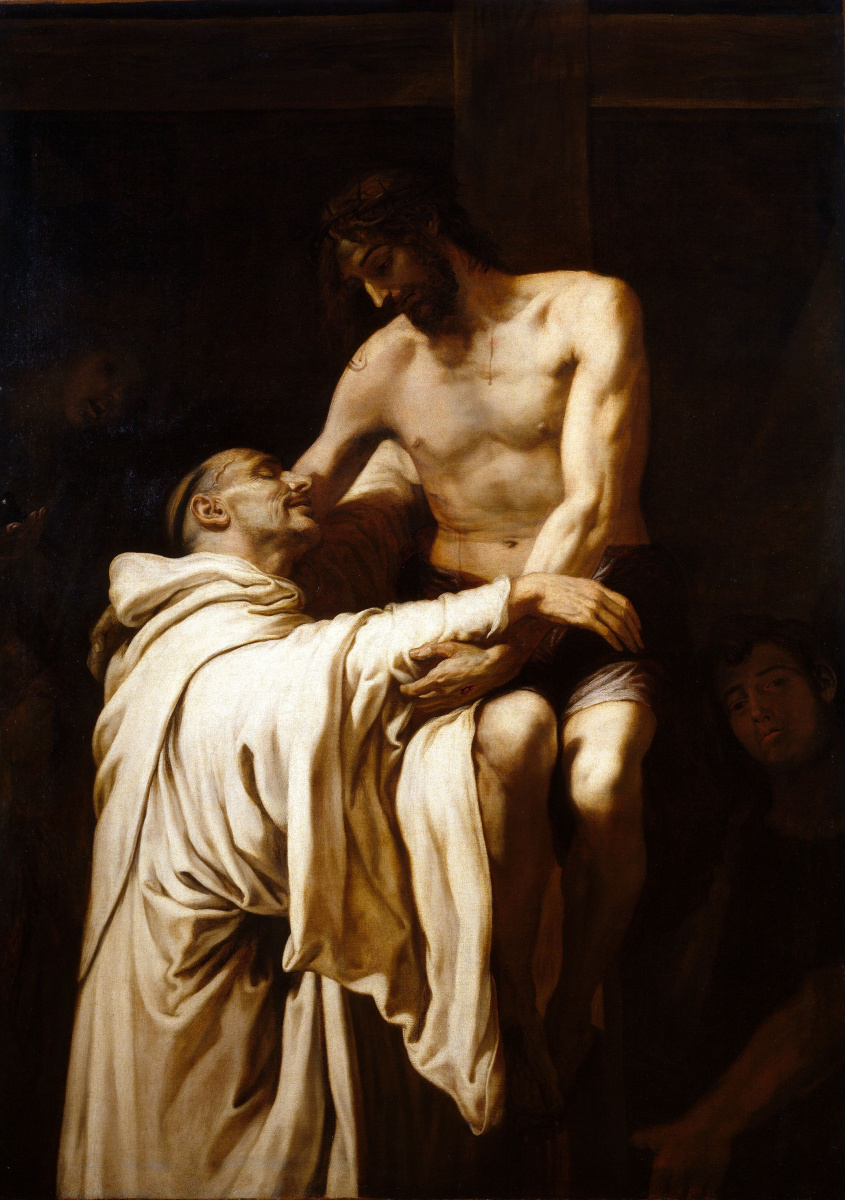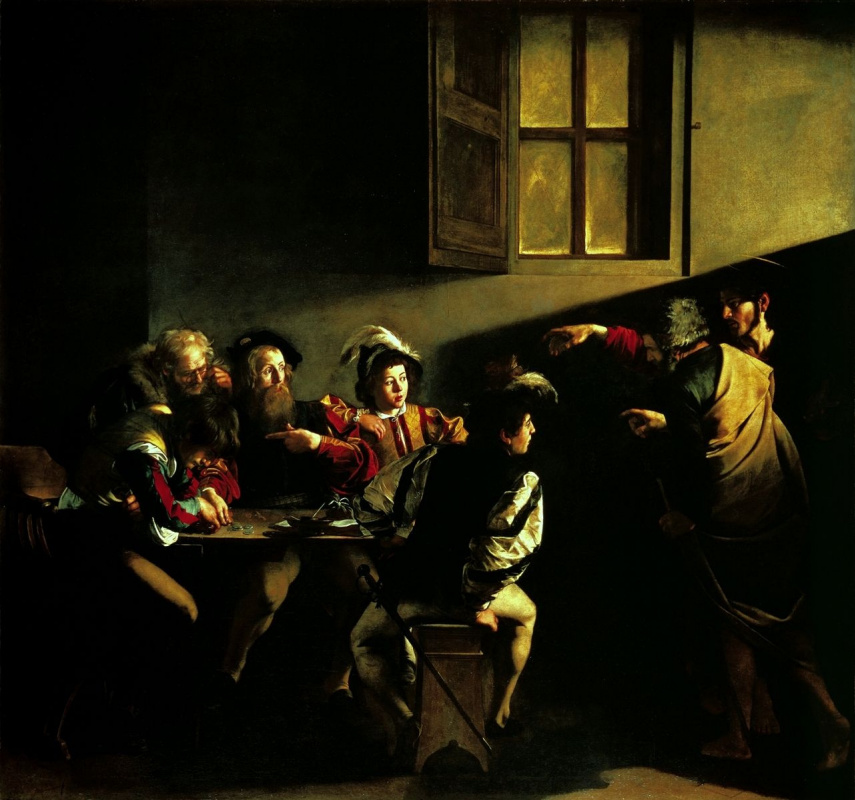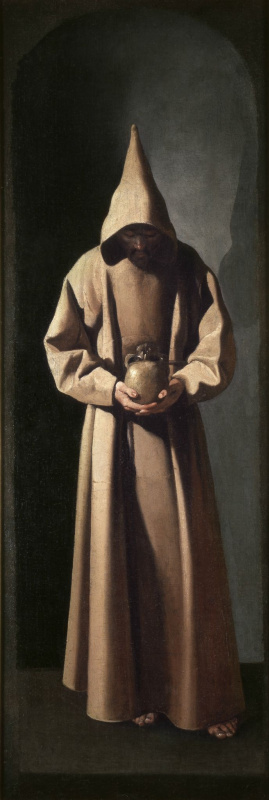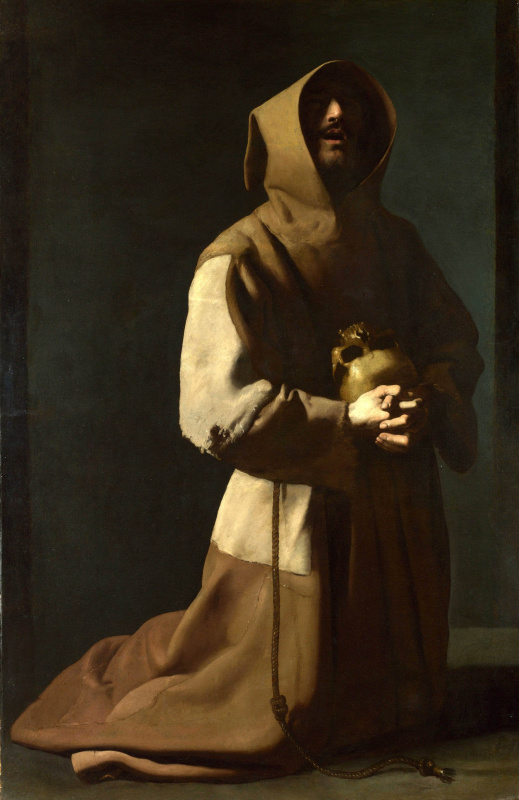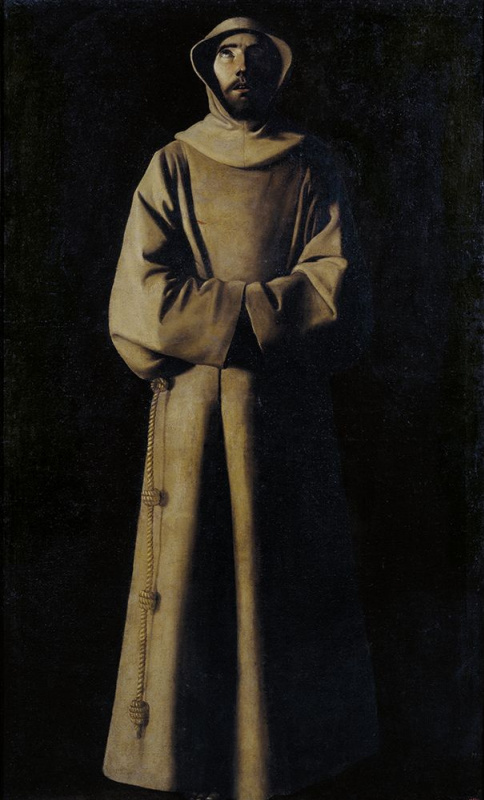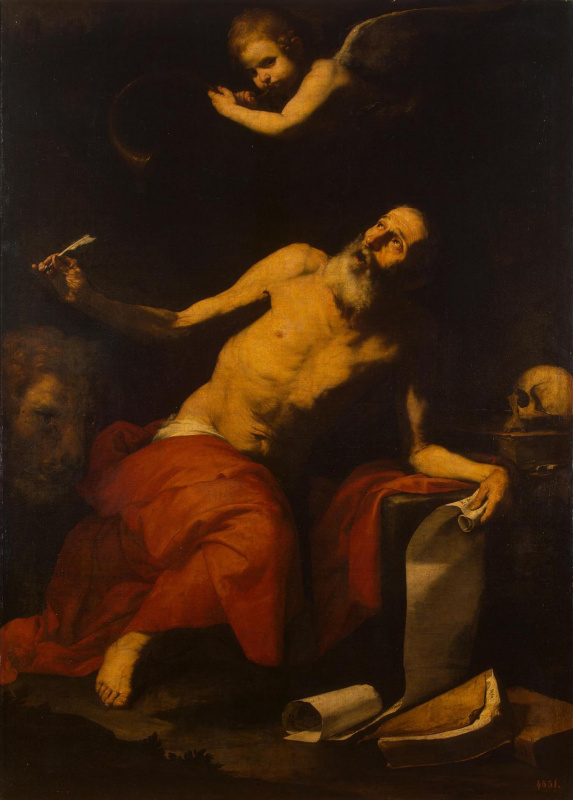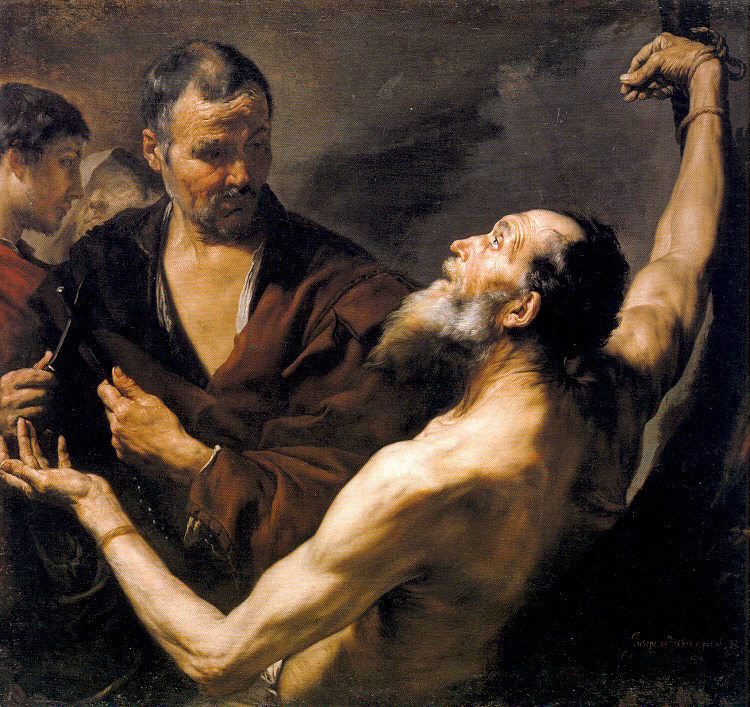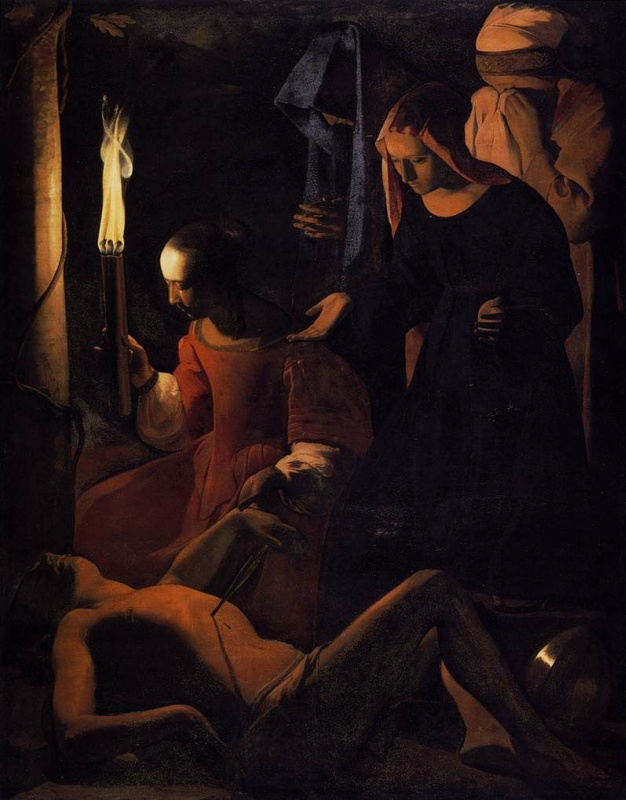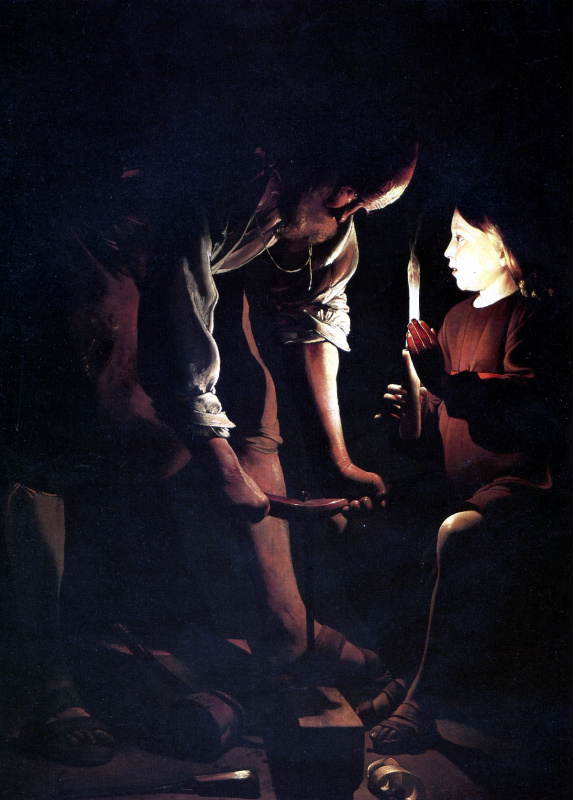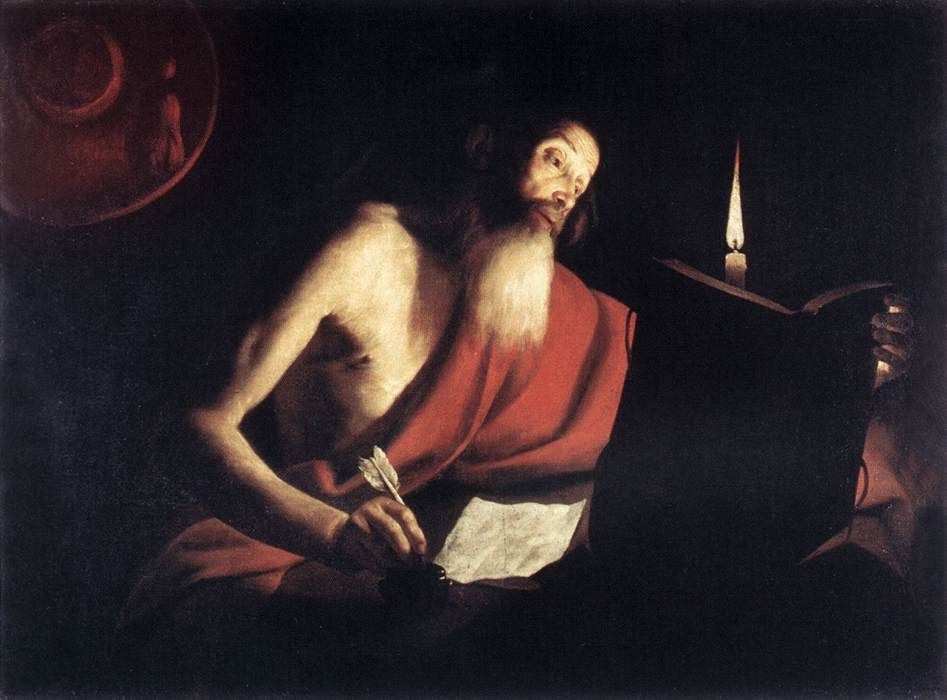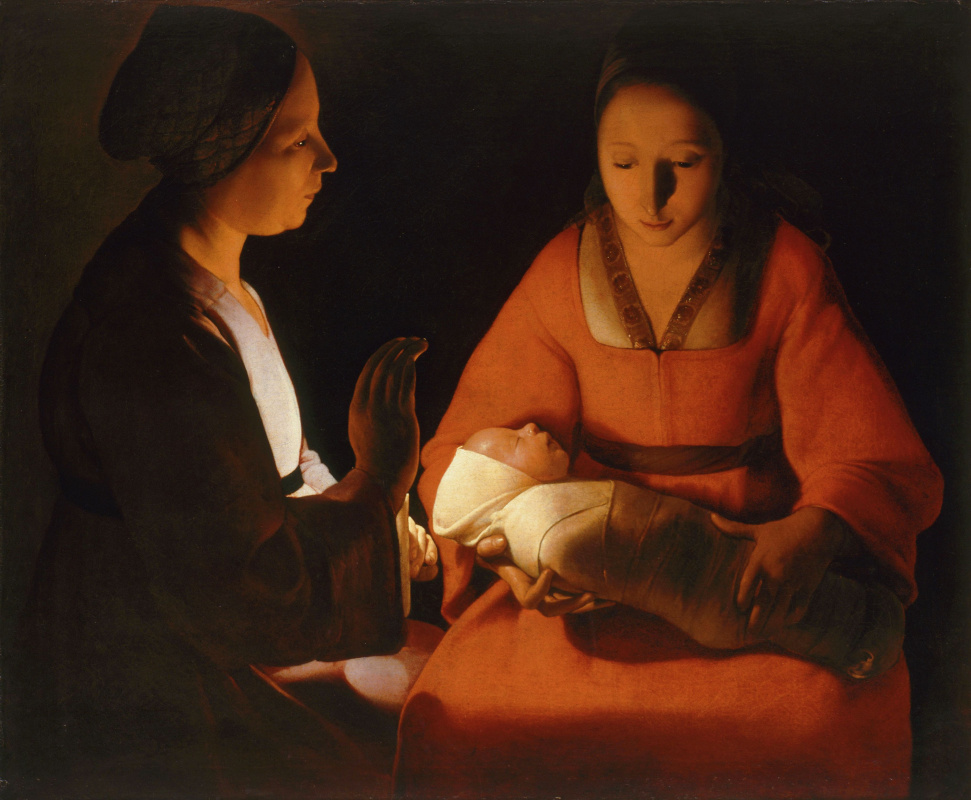"Tenebroso" from the Italian means "dark" or "gloomy". In fine art word "Tenebroso" describes a style of painting where dark colours dominate over the light ones and extreme contrasts of light and dark areas are very expressive and dramatic.

Sometimes to denote this manner of painting another word is used, the Italian one, — chiaroscuro (in Italian chiaroscuro means "light and shade"). Art movement that abused chiaroscuro has been named tenebrism and its representatives are known as tenebrists (in Spanish — Tenebrosi).
The appearance of Christ to St. Bernard
1626, 158×113 cm
The one who gave birth to the darkness and shed light
The artist Michelangelo Merisi da Caravaggio is generally credited with the invention of the tenebrism style. Style that he invented can be described as something like this. Bright light pulls out the figures positioned at the forefront of the canvas from conditional dark space. "Drawing" light gives figures a sense of three-dimensional volume. But the darkness is not willing to easily give up its positions, so thick dark shadows lie on people and objects.
Sleeping Cupid
1608, 71×105 cm
The sharp contrasts of light and dark make objects tangible and convex, and the style of Caravaggio — recognizable and memorable.
The doubting of St. Thomas
1602, 107×146 cm
"The Calling of Saint Matthew" in the church San Luigi dei Francesi in Rome became one of the most famous paintings by Caravaggio. Initially, Cesari d’Arpino, the opponent of Caravaggio, should have painted the Kontarelli chapel in frescos, but he didn’t make it.
Then Caravaggio was invited, but he has agreed to work only on his own terms, as always. Firstly, he said he would not paint in fresco, but oil on canvas. Secondly, he dressed the biblical characters in contemporary clothes. And thirdly, in any case he would not abandon his usual manner (which subsequently was called tenebroso or, in other words, chiaroscuro).
Late in the evening the tax collector Levi (Saint Matthew’s name before he became the apostle) in the company of an old man in glasses counted the day’s proceeds. And next to them, in a stream of bright light, cutting through the darkness, there are Christ and the apostle Peter, pointing to Matthew. The sharp light falling from the right and top symbolizes the power of faith, the Bible, "and the light shines in the darkness; and the darkness comprehended it not."
Then Caravaggio was invited, but he has agreed to work only on his own terms, as always. Firstly, he said he would not paint in fresco, but oil on canvas. Secondly, he dressed the biblical characters in contemporary clothes. And thirdly, in any case he would not abandon his usual manner (which subsequently was called tenebroso or, in other words, chiaroscuro).
Late in the evening the tax collector Levi (Saint Matthew’s name before he became the apostle) in the company of an old man in glasses counted the day’s proceeds. And next to them, in a stream of bright light, cutting through the darkness, there are Christ and the apostle Peter, pointing to Matthew. The sharp light falling from the right and top symbolizes the power of faith, the Bible, "and the light shines in the darkness; and the darkness comprehended it not."
The calling of St. Matthew
1600, 323×343 cm
Martin Scorsese says that Caravaggio was "a great filmmaker" and "helped" him to put light in a movie "Mean Streets".
People, sitting in gloomy bars of New York in this movie, — it’s a remake of the painting by Caravaggio "The Calling of St. Matthew".
People, sitting in gloomy bars of New York in this movie, — it’s a remake of the painting by Caravaggio "The Calling of St. Matthew".
Tenebrism - "cellar art"
The influence of "light and shadow’s revolution" of Caravaggio was so great, that it caused occurrence of whole "cellar art" schools. Sometimes "cellar" was understood quite literally: for example, in Spain at the time of Murillo (mid-XVII century) the artists settled workshops in cellars, thus it was possible to organize the space so that the light fell from above and from the side (like a cellar lighting).
The little beggar (Lousy)
1650, 134×110 cm
Realistic and rough-truthful art of Caravaggio found imitators not only in Italy: the whole Western Europe was totally over tenebrism. We can meet sharp light and shadow effects of Caravaggio in the paintings of Rubens and Jordaens, Velázquez and Zurbarán. In many countries there were its own tenebrists: Jusepe de Ribera in Spain, Trophime Bigot and Georges de La Tour in France, Gerrit van Honthorst and Judith Leyster in the Netherlands. At home of Caravaggio, in Italy, the Gentileschi dynasty gave the greatest tribute to the tenebroso method.
Tenebrism in Spane: Francisco de Zurbarán
Francisco de Zurbarán was one of the greatest Spanish painters. When he was 15 years old, he became a student to the master painting wooden figures for the religious processions. However, Zurbaran was bored to paint statues — he wanted to become a painter and learn to reliably convey the depth and volume on flat surface of the canvas.In 1627, Zurbarán painted one of his first paintings "Christ on the Cross" in tenebroso manner.
Using chiaroscuro, he managed to achieve extraordinary tangibility of the body of Christ, to convey roughness of wood and even bulge of heads of nails. The parishioners of the chapel, where "Christ on the Cross" is housed in a dark alcove, stared intently into the gloom, and, not knowing that this is a picture, took it for a sculpture.
Tenebroso implies a sharp transition from darkness to whiteness, from light to shadow. Both in the darkness and blinding light colorful manifold is lost — so, palette becomes almost monochromatic. Yet this gives the richest opportunities for transmitting texture. White, black, gray and yellow shades — that is all palette that Zurbarán needed for the painting "Agnus Dei (The Lamb of God)". However, even this minimum of art means was enough for the masterpiece. It is noteworthy that the multicolored painting "The Adoration of the Shepherds", that "Agnus Dei" served as the drawing for, is known now much less widely than the stingy in color and therefore unusually expressive "Agnus Dei".
The lamb of God (Agnus Dei )
1638, 35.6×52 cm
The sharp and a bit sinister light became the hallmark of Zurbarán. He emphasized three-dimensional figures, expressive of fabric draperies. Almost monochrome compositions in the style of tenebroso with a predominance of dark colors as well as possible transmitted the mood of religious exaltation, in which Zurbarán was a great expert. Soon Zurbarán gained the nickname of "Spanish Caravaggio"
Tenebrism became the most popular in Spain — a country of Baroque art that won the Counter-Reformation. Because the Baroque
is focused on sharp contrasts and religious exaltation. To represent the holy in tenebroso technique was almost a matter of principle since the beginning of the XVII century. Do not lag behind Spain and France: there were also get carried away tenebrism. Very often St. Jerome and Sebastian were painted in chiaroscuro, but Saint Andrew, Thomas, Francis, and others got sometimes contrasts too.
French tenebrist Georges de La Tour has spared no dark colors in depicting the saint.
Tenebroso and brief candle
Sooner or later tenebrists should have understood that they won’t get far with only cellar lighting. Then the painting began to experiment with other sources of local lighting — candles, for example, or torches.
Saint Jerome
1630-th
, 105×138 cm
Another French tenebrist artist, Georges de La Tour, went this direction even further than Trophime Bigot: he made the candle not the only source of lighting, but also one of the main characters of his paintings.
The Penitent Magdalene
XVII century, 102.2×133.4 cm
"All masterpieces of the artist are all a theater of two actors: the light and the human spirit," - enthusiastically wrote about La Tour in the twentieth century, when the artist was newly opened.
Newborn Baby (Christmas)
1648, 76×91 cm
It is interesting that in the the paintings of Georges de La Tour there is undoubted impact of Caravaggio, but La Tour probably had not seen the paintings of the great Italian. He mastered the tenebroso technique indirectly — through the works of the Dutch artists.
Renunciation of the Apostle Peter
1610-th
, 150×197 cm
The adoration of the Magi
1644, 131×107 cm
Tenebroso - "the art of severed heads"
In painting there are scenes, as if specially created for tenebroso manner. For example, Salome with the head of John the Baptist. Or Judith beheading Holofernes. Or saints that were thinking about the vanity and perishability of human existence in the intimate presence of someone’s yellowed skull.It may seem surprising or funny, but the scenes of exactly that kind is most often choosen for some reason by the artists who love the contrasts of light and shadow.
The thing is, apparently, in a drama for which tenebroso becomes really adequate technique.
The paintings of Georges de La Tour and Caravaggio are used in the title illustration.
Written by Ann Vcherashnyaya
The thing is, apparently, in a drama for which tenebroso becomes really adequate technique.
The paintings of Georges de La Tour and Caravaggio are used in the title illustration.
Written by Ann Vcherashnyaya






